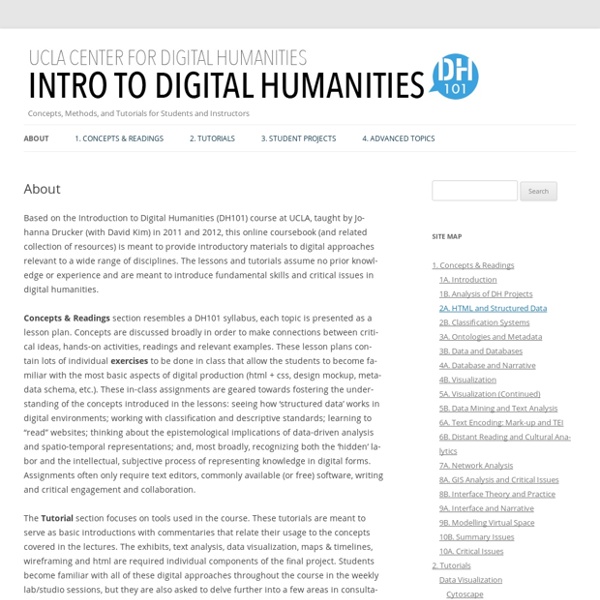



http://dh101.humanities.ucla.edu/
Related: Humanités numériques • Digital Tools • Digital HumanitiesPalladio Palladio is a toolset for easy upload and careful investigation of data. It is an intertwined set of visualizations designed for complex, multi-dimensional data. It is a product of the "Networks in History" project that has its roots in another humanities research project based at Stanford: Mapping the Republic of Letters (MRofL). MRofL produced a number of unique visualizations tied to individual case studies and specific research questions. You can see the tools on this site and read about the case studies at republicofletters.stanford.edu. With "Networks in History" we are taking the insights gained and lessons learned from MRofL and applying them to a set of visualizations that reflect humanistic thinking about data.
Text Encoding Initiative The Text Encoding Initiative (TEI) is a text-centric community of practice in the academic field of digital humanities, operating continuously since the 1980s. The community currently runs a mailing list, meetings and conference series, and maintains an eponymous technical standard, a journal, a wiki, a GitHub repository and a toolchain. TEI guidelines[edit] The TEI Guidelines, which collectively define an XML format, are the defining output of the community of practice.
What is the Spatial Turn? · Spatial Humanities “Landscape turns” and “spatial turns” are referred to throughout the academic disciplines, often with reference to GIS and the neogeography revolution that puts mapping within the grasp of every high-school student. By “turning” we propose a backwards glance at the reasons why travelers from so many disciplines came to be here, fixated upon landscape, together. For the broader questions of landscape – worldview, palimpsest, the commons and community, panopticism and territoriality — are older than GIS, their stories rooted in the foundations of the modern disciplines. These terms have their origin in a historic conversation about land use and agency.
DH Awards 2017 Results The winners of the DH Awards 2017 are as follows. Once duplicates were removed, from the 4130 ballots cast there were 4069 ballots accepted as cast by members of the public over two weeks voting for one or more of the categories. Sorry if your favoured resource did not win — open public votes are popularity contests not necessarily a measure of worth and some of the resources campaigned more successfully than the others. Since this is a DH awareness activity, if lots of people saw your favoured resource, then we all win! Best Use of DH For Fun Winner: Cancionero Runner Up: Visual Runner Up: Other Nominees (alphabetically): Total Votes In Category: 1891
Exploring Big Historical Data: The Historian's Macroscope Welcome to the companion site for Exploring Big Historical Data: The Historian’s Macroscope, published by Imperial College Press. If you want to buy a copy, you can purchase one for $39.00 USD. Feel free to visit our original live-written fully open draft website, which is still online – and if you like what you see, you can always buy the book! Mapping redheads: which country has the most? A couple of months ago this map did the rounds. It's quite nice right? It shows that in most of Scotland and Ireland, as well as a random patch in central Russia, 10% of people are of the ginger genre.
Historical Network Research 1) Start with some introductory texts on Social Network Analysis Among the general HNR articles in the Bibliography, Scott Weingart’s blog post series “Networks Demystified” and Claire Lemercier’s article “Formal network methods in history” are particularly useful to get you ideas. To get a first idea of Social Network Analysis terminology and concepts, you may find this Cheat Sheet helpful. A great resource which will help you understand what you can expect from Social Network Analysis is Valdis Krebs’ Network Discovery Matrix. 2) Find answers to these questions: 1.
GETTING STARTED: introductions & guides - Digital Humanities - Subject & Course Guides at University of Kansas A Companion to Digital Humanities, ed. Susan Schreibman, Ray Siemens, John Unsworth. Oxford: Blackwell, 2004. Spatial Humanities This five-year project runs from 2012-16 and is funded by the European Research Council under a Starting Researcher Grant. Our aim is to create a step-change in how place, space and geography are explored in the Humanities. Building on Lancaster University’s technical expertise in Digital Humanities, Corpus Linguistics and Geospatial Analysis, as well as its applied expertise in the history of the English Lake District, we are developing and applying methodologies for analysing unstructured texts—including large corpora of historical books, periodicals and official reports—within a Geographic Information Systems (or GIS) environment. Recent Posts Please check back soon!
Projects – DH LAB Data by Design Data by Design: An Interactive History of Data Visualization, 1786-1900, challenges the commonly-held belief that visualization serves as a neutral method for data’s display. In a series of five “data narratives” —chapter-length web-based texts that employ interactive visualizations in order to advance their claims— this project traces the rise of modern data visualization techniques. (Read more…) The Shape of History A project that brings together theories of speculative design with original archival research in order to ask how forgotten histories of data visualization can help us to imagine new forms and platforms for data’s display.
Forum: The Status Quo of Digital Humanities in Europe In October and November 2014, H-Soz-Kult publishes a series of essays on "The Status Quo of Digital Humanities in Europe". Please find the published texts of this essay series here: Editorial Editorial: The Status Quo of Digital Humanities in Europeby Torsten Kahlert and Claudia Prinz, Humboldt-University of Berlin